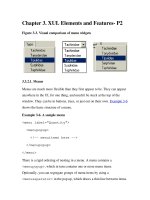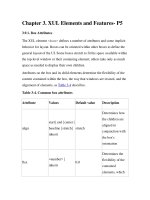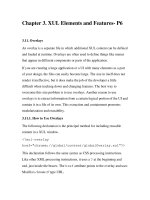Chapter 3 v7 01
Bạn đang xem bản rút gọn của tài liệu. Xem và tải ngay bản đầy đủ của tài liệu tại đây (2.35 MB, 109 trang )
©1996-2016, J.F Kurose and K.W. Ross
Computer Networks
Lectured by:
Nguyen Le Duy Lai
()
Computer
Networking: A Top
Down Approach
7th Edition, Global Edition
Jim Kurose, Keith Ross
Pearson
April 2016
Introduction
1-1
©1996-2016, J.F Kurose and K.W. Ross
Chapter 3
Transport Layer
Computer
Networking: A Top
Down Approach
7th Edition, Global Edition
Jim Kurose, Keith Ross
Pearson
April 2016
Transport Layer 2-2
Chapter 3: Transport Layer
our goals:
©1996-2016, J.F Kurose and K.W. Ross
▪ understand
principles behind
transport layer
services:
• Multiplexing (mux),
demultiplexing
(demux)
• reliable data transfer
(rdt)
• flow control
• congestion control
▪ learn about Internet
transport layer protocols:
• UDP: connectionless
transport
• TCP: connection-oriented
reliable transport
• TCP flow control
• TCP congestion control
Transport Layer
3-3
©1996-2016, J.F Kurose and K.W. Ross
Chapter 3: outline
3.1 transport-layer
services
3.2 multiplexing and
demultiplexing
3.3 connectionless
transport: UDP
3.4 principles of reliable
data transfer
3.5 connection-oriented
transport: TCP
•
•
•
•
segment structure
reliable data transfer
flow control
connection management
3.6 principles of congestion
control
3.7 TCP congestion control
Transport Layer
3-4
©1996-2016, J.F Kurose and K.W. Ross
Transport services and protocols
▪ provide logical communication
between app processes
running on different hosts
▪ transport protocols run in
end systems
• send side: breaks app
messages into segments,
passes to network layer
• receive side: reassembles
segments into messages,
passes to app layer
▪ more than one transport
protocol available to apps
• Internet: TCP and UDP
application
transport
network
data link
physical
application
transport
network
data link
physical
Transport Layer
3-5
Transport vs. network layer
▪ network layer
▪ logical communication
between hosts
©1996-2016, J.F Kurose and K.W. Ross
▪ transport layer
▪ logical communication
between processes
▪ relies on, enhances,
network layer services
household analogy:
12 kids in Ann’s house sending
letters to 12 kids in Bill’s
house:
▪ hosts = houses
▪ processes = kids
▪ app messages = letters in
envelopes
▪ transport protocol = Ann and
Bill who demux to in-house
siblings
▪ network-layer protocol =
postal service
Transport Layer
3-6
Internet transport-layer protocols
▪ reliable, in-order delivery:
TCP
©1996-2016, J.F Kurose and K.W. Ross
• connection setup
• flow control
• congestion control
▪ possibly unreliable,
unordered delivery: UDP
• no-frills extension of
“best-effort” IP
▪ services not available:
application
transport
network
data link
physical
network
data link
physical
network
data link
physical
network
data link
physical
network
data link
physical
network
data link
physical
network
data link
physical
network
data link
physical
application
transport
network
data link
physical
• delay guarantees
• bandwidth guarantees
Transport Layer
3-7
©1996-2016, J.F Kurose and K.W. Ross
Chapter 3 outline
3.1 transport-layer
services
3.2 multiplexing and
demultiplexing
3.3 connectionless
transport: UDP
3.4 principles of reliable
data transfer
3.5 connection-oriented
transport: TCP
•
•
•
•
segment structure
reliable data transfer
flow control
connection management
3.6 principles of congestion
control
3.7 TCP congestion control
Transport Layer
3-8
Multiplexing/demultiplexing
multiplexing at sender:
handle data from multiple
sockets, add transport header
(later used for demultiplexing)
demultiplexing at receiver:
use header info to deliver
received segments to correct
socket
application
©1996-2016, J.F Kurose and K.W. Ross
application
P3
P1
P2
application
P4
transport
transport
network
transport
network
link
network
physical
link
link
physical
socket
process
physical
Transport Layer
3-9
How demultiplexing works
©1996-2016, J.F Kurose and K.W. Ross
▪ host receives IP datagrams
• each datagram has source IP
address, destination IP address
• each datagram carries one
transport-layer segment
• each segment has source,
destination port number
▪ host uses IP addresses &
port numbers to direct
segment to appropriate
socket
32 bits
source port #
dest port #
other header fields
application data
(payload)
TCP/UDP segment format
Transport Layer
3-10
Connectionless demultiplexing
▪ recall: created socket has
host-local port #:
©1996-2016, J.F Kurose and K.W. Ross
DatagramSocket mySocket1
= new
DatagramSocket(12534);
▪ when host receives UDP
segment:
• checks destination port #
in segment
• directs UDP segment to
socket with that port #
▪ recall: when creating
datagram to send into
UDP socket, must specify
• destination IP address
• destination port #
IP datagrams with same
dest. port #, but different
source IP addresses
and/or source port
numbers will be directed
to same socket at dest
Transport Layer
3-11
Connectionless demux: example
DatagramSocket
mySocket2 = new
DatagramSocket
(9157);
DatagramSocket
serverSocket = new
DatagramSocket
DatagramSocket
mySocket1 = new
(6428);
DatagramSocket
(5775);
application
application
application
P1
P3
P4
transport
©1996-2016, J.F Kurose and K.W. Ross
transport
transport
network
network
link
network
link
physical
link
physical
physical
source port: 6428
dest port: 9157
source port: 9157
dest port: 6428
source port: ?
dest port: ?
source port: ?
dest port: ?
Transport Layer
3-12
Connection-oriented demux
▪ TCP socket identified
by 4-tuple:
©1996-2016, J.F Kurose and K.W. Ross
•
•
•
•
source IP address
source port number
dest IP address
dest port number
▪ demux: receiver uses
all four values to direct
segment to appropriate
socket
▪ server host may support
many simultaneous TCP
sockets:
• each socket identified by its
own 4-tuple
▪ E.g., web servers have
different sockets for
each connecting client
• non-persistent HTTP will
have different socket for
each request
Transport Layer
3-13
Connection-oriented demux: example
application
application
P4
P5
application
P6
P1
P3
P2
transport
network
network
link
network
link
physical
link
physical
©1996-2016, J.F Kurose and K.W. Ross
transport
transport
host: IP
address A
server: IP
address B
source IP,port: B,80
dest IP,port: A,9157
source IP,port: A,9157
dest IP, port: B,80
three segments, all destined to IP address: B,
dest port: 80 are demultiplexed to different sockets
physical
host: IP
address C
source IP,port: C,5775
dest IP,port: B,80
source IP,port: C,9157
dest IP,port: B,80
Transport Layer
3-14
Connection-oriented demux: example
threaded server
application
application
application
P4
P3
P3
P2
transport
network
network
link
network
link
physical
link
physical
©1996-2016, J.F Kurose and K.W. Ross
transport
transport
host: IP
address A
server: IP
address B
source IP,port: B,80
dest IP,port: A,9157
source IP,port: A,9157
dest IP, port: B,80
physical
host: IP
address C
source IP,port: C,5775
dest IP,port: B,80
source IP,port: C,9157
dest IP,port: B,80
Transport Layer
3-15
©1996-2016, J.F Kurose and K.W. Ross
Chapter 3 outline
3.1 transport-layer
services
3.2 multiplexing and
demultiplexing
3.3 connectionless
transport: UDP
3.4 principles of reliable
data transfer
3.5 connection-oriented
transport: TCP
•
•
•
•
segment structure
reliable data transfer
flow control
connection management
3.6 principles of congestion
control
3.7 TCP congestion control
Transport Layer
3-16
©1996-2016, J.F Kurose and K.W. Ross
UDP: User Datagram Protocol [RFC 768]
▪ “no frills,” “bare bones”
Internet transport
protocol
▪ “best effort” service,
UDP segments may be:
• lost
• delivered out-of-order
to app layer
▪ connectionless:
• no handshaking
between UDP sender,
receiver
• each UDP segment
handled independently
of others
▪ UDP use:
▪ streaming multimedia
apps (loss tolerant, rate
sensitive)
▪ DNS
▪ SNMP
▪ reliable transfer over
UDP:
▪ add reliability at
application layer
▪ application-specific error
recovery!
Transport Layer
3-17
UDP: segment header
©1996-2016, J.F Kurose and K.W. Ross
32 bits
source port #
dest port #
length
checksum
Application data
(payload)
UDP segment format
length (in bytes) of
UDP segment,
including header
why is there a UDP?
▪ no connection establishment
(which can add delay)
▪ simple: no connection
state at sender, receiver
▪ small header size
▪ no congestion control: UDP
can blast away as fast as
desired
Transport Layer
3-18
UDP checksum
Goal: detect “errors” (e.g., flipped bits) in transmitted
segment
©1996-2016, J.F Kurose and K.W. Ross
sender:
▪ treat segment contents,
including header fields,
as sequence of 16-bit
integers
▪ checksum: addition
(one’s complement sum)
of segment contents
▪ sender puts checksum
value into UDP
checksum field
receiver:
▪ compute checksum of
received segment
▪ check if computed
checksum equals checksum
field value:
• NO - error detected
• YES - no error detected.
But maybe errors
nonetheless? More later
….
Transport Layer
3-19
Internet checksum: example
example: add two 16-bit integers
1 1 1 1 0 0 1 1 0 0 1 1 0 0 1 1 0
1 1 1 0 1 0 1 0 1 0 1 0 1 0 1 0 1
©1996-2016, J.F Kurose and K.W. Ross
wraparound 1 1 0 1 1 1 0 1 1 1 0 1 1 1 0 1 1
sum 1 1 0 1 1 1 0 1 1 1 0 1 1 1 1 0 0
checksum 1 0 1 0 0 0 1 0 0 0 1 0 0 0 0 1 1
Note: when adding numbers, a carryout from the most
significant bit needs to be added to the result
* Check out the online interactive exercises for more
examples: />
Transport Layer
3-20
©1996-2016, J.F Kurose and K.W. Ross
Chapter 3 outline
3.1 transport-layer
services
3.2 multiplexing and
demultiplexing
3.3 connectionless
transport: UDP
3.4 principles of reliable
data transfer (rdt)
3.5 connection-oriented
transport: TCP
•
•
•
•
segment structure
reliable data transfer
flow control
connection management
3.6 principles of congestion
control
3.7 TCP congestion control
Transport Layer
3-21
Principles of reliable data transfer
▪ important in application, transport, link layers
â1996-2016, J.F Kurose and K.W. Ross
ã top-10 list of important networking topics!
▪ characteristics of unreliable channel will determine
complexity of reliable data transfer protocol (rdt)
Transport Layer
3-22
Principles of reliable data transfer
▪ important in application, transport, link layers
â1996-2016, J.F Kurose and K.W. Ross
ã top-10 list of important networking topics!
expected
Real state
▪ characteristics of unreliable channel will determine
complexity of reliable data transfer protocol (rdt)
Transport Layer
3-23
Principles of reliable data transfer
▪ important in application, transport, link layers
â1996-2016, J.F Kurose and K.W. Ross
ã top-10 list of important networking topics!
▪ characteristics of unreliable channel will determine
complexity of reliable data transfer protocol (rdt)
Transport Layer
3-24
Reliable data transfer: getting started
rdt_send(): called from above,
(e.g., by app.), passed data to
deliver to receiver upper layer
©1996-2016, J.F Kurose and K.W. Ross
send
side
udt_send(): called by rdt,
to transfer packet over
unreliable channel to receiver
deliver_data(): called by
rdt to deliver data to upper
receive
side
rdt_rcv(): called when packet
arrives on rcv-side of channel
Transport Layer
3-25









